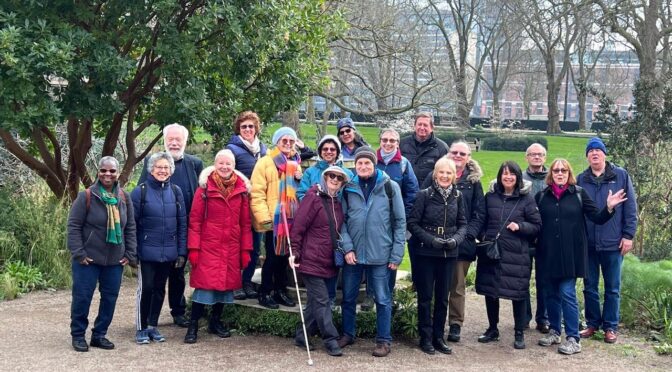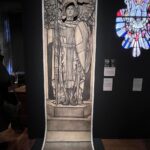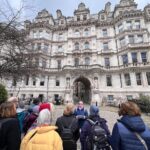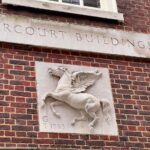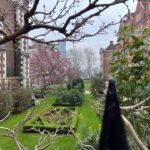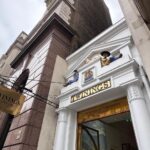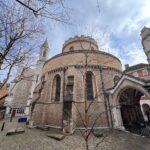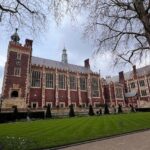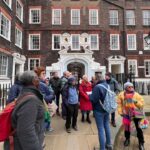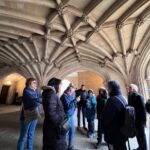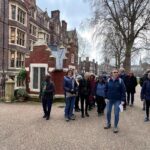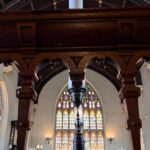There were two groups of walkers meeting at Temple tube station: Capital Walkers and the Polyramblers. Some Capitals Walkers were attracted to our group, but we had to disappoint them. Anyway, upon checking their programme, I discovered that they were doing an 11-mile walk. Ours was 3 miles but was going to include a lot of interesting stops.
There were 19 of us and our first stop was at Two Temple Place, a beautiful building built for William Waldorf Astor in 1895. It’s not open very often but there is a free exhibition on glass until 21 April so we spent half an hour inside admiring the glass and the building. Then, we started exploring the first two out of four Inns of Court: Inner Temple and Middle Temple, by going through an elaborate archway.
We passed 16th century Middle Temple Hall where Shakespeare’s company performed Twelfth Night in February 1602 and where you can book to eat a very nice lunch Monday to Friday https://www.middletemple.org.uk/lunch . After Middle Temple Gardens, we joined the Strand, passed the premises of Twining Teas and re-entered Temple into Middle Temple Lane. We went into Pump Court and Elm Court and then had lunch in the nice Garden Room Café. We admired Inner Temple gardens and the Hall, Treasury and Library of the Inner Temple. We went into Church Court where Temple Church is situated. It is now famous for the book ‘The Da Vinci Code’ and there is an entry fee unless you go for a service. The round section of Temple Church was built by the Knights Templars in 1185 and the chancel added in the 13th century. It is shared by Middle and Inner Temple.
After a short detour into Hare Court, we went into Chancery Lane, passed the old Public Records Office – which is now part of Kings College – the former Law Fire Insurance Office and the Law Society building. Then it was into Carey Street and the Silver Mousetrap shop (1690), the Seven Stars pub (1602) and the entrance to Lincoln’s Inn. We admired the gardens, hall and library and the Ostler’s Hut, designed by George Gilbert Scott in 1852. It is London’s smallest listed building. It was essentially a porter’s hut. An ‘ostler’ was someone who traditionally looked after horses. The next stop was Lincoln’s Inn chapel undercroft and the beautiful chapel whose foundation stone was laid by John Donne in 1620. We admired the coats of arms of the treasurers of Lincoln’s Inn over the centuries – the Treasurer being the most senior position at the Inn.
Another stop was the impressive London Silver Vaults which offer the largest underground retail selection of fine antique and contemporary silver in the world. They originally opened in 1885 as ‘The Chancery Lane Safe Deposit’ but also became a secure place for London’s silver and jewellery dealers. The present building opened in 1953. No photos allowed. Shame as the steel door to go into the vaults is impressive. Not sure I would like to polish all that silver though!
We went through Staple Inn and into Holborn. There, we were abandoned by 6 Polyramblers who decided to go with Danny to a pub which he recommended. The rest of the group continued the walk and went to view Barnards Inn (now used by Gresham College) and the Prudential Insurance building. We had a peep into the amazing Cittie of Yorke pub.
We entered Gray’s Inn where a young Charles Dickens worked at number 1, the only building to survive wartime bombing. The library, hall and chapel were all reconstructed after WWII. We were too late to go into Gray’s Inn Gardens known as ‘The Walks’ – open only from 12 noon until 2.30pm Monday to Friday. After passing Bedford Row, we crossed High Holborn and went into Lincoln’s Inn Fields, saw Dickens’ Old Curiosity Shop, then through the LSE buildings and ended up in the Strand by St Clement’s Danes Church. We went in, lit a few candles and made our way to Temple tube station.
We finished our 3 mile walk at 3.45pm. The Capital Walkers’ planned finishing time for their 11-mile walk was 4.00pm. But I am sure (without boasting) that our walk was more interesting.
This walk was sourced from London-footprints.co.uk, click here if you would like to view the instructions for this walk on that website.
Dominique

